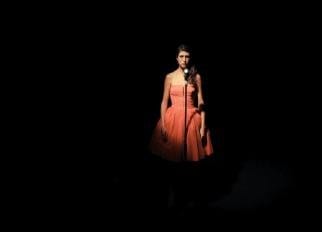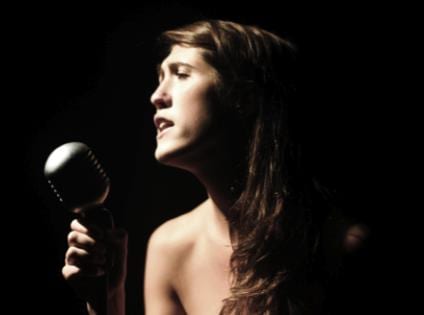We don’t usually associate paralyzing depression with a desire to break into song.
But this curious conceit forms the core of writer/performer Amy Nostbakken’s The Big Smoke, her solo a cappella musical about a woman in the depths of despair.
Though the Ottawa native’s background is in physical theatre, for this project she opted to put her voice front and centre. More than simply an exciting challenge, working exclusively with song meant connecting with her audience in a deeper way.
“Music is an amazing tool to work with because it touches us instinctively in all of these ways you can’t achieve with words alone,” Nostbakken says. “It’s a big risk for me, because I’ve never used my voice in a show in this way before. It’s just me and my microphone and my dress. I don’t have any other performers or musicians to fall back on if I screw something up.”
The Big Smoke centres on Nathalie, a young Canadian artist who’s miserable, despite having the life she’s always wanted. Beautiful, talented and successful, with a loving family and an art career set to explode (courtesy of a once-in-a-lifetime chance at a solo exhibition at London’s Tate Modern gallery), Nathalie can’t seem to be happy with what she has. Alienated by the gossiping socialites and pretentious art-world types who surround her, she seems ready to give up life entirely.
“Nathalie is struggling to find her place in society and meaning in her life, when everyone else thinks those things should be obvious,” Nostbakken says. “I was curious about the 21st-century condition of having previously unheard-of levels of personal choice, while at the same time feeling so restricted. Everyone has had a point in their lives where they were depressed, even though they felt like they shouldn’t be. But it’s less a story of depression than it is of someone fighting for life.”
Though she’s never struggled with serious depression herself, Nostbakken’s interest in the subject was piqued while helping a close friend through the tragic death of a child. In researching women’s experiences with depression, she turned to the works of Anne Sexton, Sylvia Plath and Virginia Woolf, three successful writers who suffered lifelong depression that ultimately resulted in suicide.
Though the show doesn’t specifically discuss any of the writers, traces of their poetry filter through the songs.
“I wanted to write a strong female character dealing with tragedy, which each of them was,” Nostbakken says. “They all wrote about subjects women in their time were dealing with but everyone else was afraid to touch. It was all blood and guts, everything out on the table kind of writing. They were fearless, but in the end each of them felt like they didn’t have a place in the world.
“All of them shared this feeling of being out of place in their respective times,” she adds. “Like there was something wrong with them, rather than with the world. It’s an immense mind fuck that they each ended their lives at the height of their talent.”
Nostbakken is a recent transplant to Toronto, having spent the last seven years in Europe. Originally, she moved to Paris to study at famed theatre school Lecoq, later relocating to London, since it was easier to create work in English there.
“I wasn’t sure I would like Toronto when I first arrived, but I’m discovering everything it has to offer,” she says. “I feel like I can contribute to shaping the cultural landscape here. It seems like a city that’s constantly evolving. It feels like a place where people welcome change.”
The Deets:
The Big Smoke
Runs until Sun, March 4
Factory Studio Theatre
125 Bathurst St



 Why you can trust Xtra
Why you can trust Xtra


